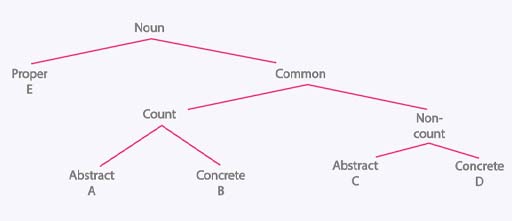2.3 All the noun types together
Although so far you’ve focused on each category of nouns separately, nouns can be classified into more than one group. This should be clear if you look at how the categories relate to each other in the tree diagram below.
Activity 7 Where in the tree does the noun go?
Look at the tree diagram in Figure 4 and consider the following words:
banana, idea, Napoleon, petrol, revenge
Which word goes at A, B, C, D and E, and what categories does each fall under as a result? The first one has been done for you.
Discussion
A. idea – a common, count, abstract noun
B. banana – a common, count, concrete noun
C. revenge – a common, non-count, abstract noun
D. petrol – a common, non-count, concrete noun
E. Napoleon – a proper noun

